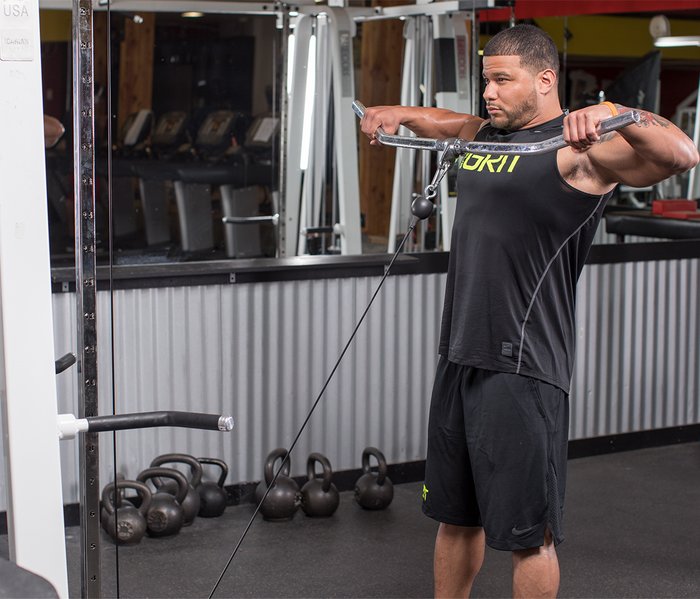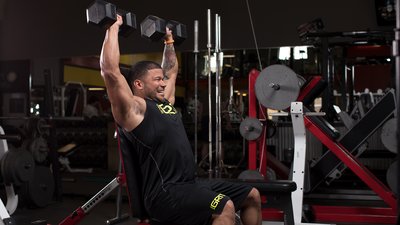More than perhaps any other body part, shoulder training often has to tiptoe a line between good pain and bad. Your workout should feel gritty, but your shoulders shouldn't feel, well, shitty.
In other words, this is one group where it makes sense to train smarter and harder, not just one or the other. Here are six of my favorite ways to get it done.
1. Landmine with Press
The angled barbell press is a great exercise because it not only integrates the hips and torso muscles, it's a shoulder-friendly pressing option that many people who get shoulder pain with overhead pressing can perform without discomfort.
That said, as it's normally performed it has one disadvantage: As the barbell becomes more upright, the mechanical advantage increases, meaning the weight gets easier to lift. The solution is easy: Add a superband to this exercise in order to increase resistance as you get closer to lockout.

Anchor the band underneath the same-side foot as the arm you're using to press.
Even a thin band will add a serious amount of difficulty to this movement, but if you find you need more tension from the band and don't have access to a thicker one, simply wrap the band around your anchor foot once to shorten it.
Another nice thing about this move is it's versatile. You can do this move for as few as 5 reps per set for a strength stimulus, or as many as 15 for a metabolic burnout.
2. Kettlebell Shoulder-To-Shoulder Press
This is a unique kettlebell exercise that works the shoulders a bit differently than more conventional overhead pressing variations because your shoulders are forward, rather than out to the sides. You also get a bit of core work because the weight is offset, which offers a benefit almost like doing a side plank.

This exercise also shifts the weight so that one arm is the primary mover and the other is secondary. For the next rep it's reversed, but both are still working to some degree. That creates a different stimulus where it's not a one-arm or two-arm press—it's somewhere in between.
To do this exercise, hold the kettlebell with your thumbs hooked around the handle at your right shoulder with your elbows underneath it. Press it above your head, then lower it to your other shoulder, then reverse it. The motion is in the shape of a triangle.
3. Angled Shoulder Raise
When doing lateral shoulder raises, the go-to plane of motion is straight out to the side. I'm a big fan of ignoring the status quo here, and lifting my arms in what is known as the scapular plane, at roughly a 30-degree angle to the torso.

Research has demonstrated that performing shoulder exercises in the scapular plane creates the same demands on the shoulder musculature, but lessens the unwanted stress on the rotator cuff tendon.[1,2]
Alternately, you can also do 45-degree shoulder raises, which is the middle ground between front raises and side raises, as I demonstrated in the video workout "The Gritty Workout Your Upper Body Needs."
Want to make these even harder? Perform them pause-go style. This means you hold the top position for 8-10 seconds at the start of the set, then perform 8-10 smooth reps.

4. Scapular Plane Overhead Press
What works for raises also works for presses. Rather than holding your arms straight out to the side, try keeping them at an angle to the torso, in the scapular plane.

To be clear, this doesn't completely eliminate stress on your rotator cuff, because some is inevitable. Every time you raise your arm overhead there is some level of contact or impingement of the rotator cuff on the acromion.[3] But contact doesn't have to mean inflammation, irritation, or injury—the hallmarks of "shoulder impingement syndrome."
Performing the dumbbell overhead press in the scapular plane is a simple strategy to be able to do more of the work you want, with less of the unwanted stress on the joint.
5. Dumbbell Shoulder Press 21s
I've never understood why bodybuilders and general lifters only apply the 21s concept to train their biceps. The way I see it, 21s are a simple, versatile overload technique that you can easily apply to virtually any strength exercise, allowing you to really goose a target muscle with a relatively light weight.
Rather than the traditional "bottom half/top half/full ROM" approach, I prefer to mix reps with strategic isometric holds, similar to the Updated Biceps 21s section in "The 6 Grittiest Biceps Exercises You're Not Doing." You can do this version either standing or seated.

Here's the protocol:
- 7 mid-range partial reps
- 7-second mid-range isometric hold, opening and closing your arms (Arnold press style)
- 7 full-ROM reps
Why focus so much on the middle range of motion? For one, muscles have the lowest potential to generate force when they're either fully elongated (stretched) or fully shortened (contracted). They generate the highest possible tension in the middle—halfway through the range of motion.[4,5]
Another reason to focus on the mid-range is because it's the position where maximum loading of the shoulders occurs. During the overhead press, the shoulders are maximally loaded at the point in the ROM where the humerus (upper arm bone) is at a 90-degree angle with the load vector, which is the pull of gravity.
The farther away you move from a 90-degree angle with the load vector, the shorter the lever arm becomes and the less work your shoulders have to do. This is why lifters typically rest between reps at the top and bottom position of the shoulder press. No rest is happening at 90 degrees!
6. Wide-Grip Cable Upright Rows
Upright rows are a move where many lifters and coaches struggle to find the sweet spot between pain and gain. But that's not a reason to kick the movement to the curb, it's just an opportunity to look for a better way.
The traditional way of performing them, using a barbell with the hands close in the middle, has several downsides. For one, it maximizes biceps involvement. A 2013 study concluded that deltoid and trapezius activity increased the wider the grip got—and lessened involvement for the biceps brachii.[6] If your goal with this movement is to hit the shoulders and traps—as it should be—lesson one is to go wide.

Now for the real reason people skip upright rows: shoulder pain and impingement. This has everything to do with how high you pull. Studies indicate that impingement typically peaks between 70 and 120 degrees of glenohumeral elevation. The precise number is going to vary for different people, but the authors of a 2011 paper recommend that asymptomatic individuals elevate their arms during the upright row to just below 90 degrees (shoulder height).[7] Other studies agree with the "no higher than parallel" approach.
Lastly, I prefer to perform wide-grip upright rows with a low cable. Stand a few steps back from the cable so you're pulling the weight up at a slight angle. Doing upright rows at a slight angle allows you to get a bit more range of motion at the top, relative to what you typically get when pulling straight up against a barbell or dumbbell.
This way, you'll give your delts the maximum amount of the tension they like, but the minimum of the impingement they don't. Get wide, don't get hurt!
References
- Johnston, T. B. (1937). The movements of the shoulder‐joint a plea for the use of the' plane of the scapula' as the plane of reference for movements occurring at the humero‐scapular joint. British Journal of Surgery, 25(98), 252-260.
- Greenfield, B. (1994). Special considerations in shoulder exercises: plane of the scapula. The Athlete’s Shoulder. Churchill Livingstone, New York, 513-522.
- Flatow, E. L., Soslowsky, L. J., Ticker, J. B., Pawluk, R. J., Hepler, M., Ark, J., ... & Bigliani, L. U. (1994). Excursion of the rotator cuff under the acromion: patterns of subacromial contact. The American Journal of Sports Medicine, 22(6), 779-788.
- Lieber, R. L., & Bodine-Fowler, S. C. (1993). Skeletal muscle mechanics: implications for rehabilitation. Physical Therapy, 73, 844-844.
- Smith, L. K., Weiss, E. L., & Lehmkuhl, L. D. (1996). Muscle activity and strength. Brunnstrom's Clinical Kinesiology. 5th ed. Philadelphia, Pa.: F A Davis, 137-8.
- McAllister, M. J., Schilling, B. K., Hammond, K. G., Weiss, L. W., & Farney, T. M. (2013). Effect of grip width on electromyographic activity during the upright row. The Journal of Strength & Conditioning Research, 27(1), 181-187.
- Schoenfeld, B., Kolber, M. J., & Haimes, J. E. (2011). The upright row: Implications for preventing subacromial impingement. Strength & Conditioning Journal, 33(5), 25-28.




